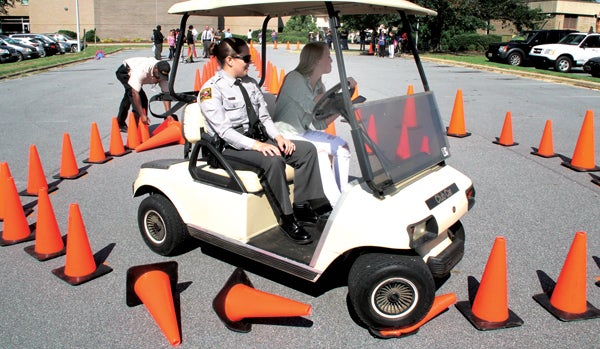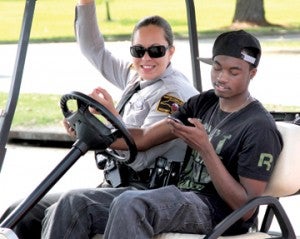Deadly Mix: Traffic + Texting
Published 7:49 am Tuesday, September 23, 2014

Orange cones were the “victims” when local students attempted to maneuver through a course while texting and driving last week at Roanoke-Chowan Community College. Staff Photo by Cal Bryant
AHOSKIE – They giggled, knocked over a few orange cones, and returned to class.
Hopefully, they got the message…not in the form of a text.
Last week, the Ahoskie office of the North Carolina Highway Patrol conducted a campaign at Roanoke-Chowan Community College aimed at encouraging young people about the dangers of distracted driving.
NCHP First Sgt. Mike Warren and Trooper K.R. Genao conducted the campaign, one that involved college and Early College High School students.

The eyes of this student are fixed on his smart phone as he receives a message while behind the wheel as NC Highway Patrol Trooper K.R. Genao serves as the onboard observer. Staff Photo by Cal Bryant
“I really appreciate the opportunity to come here and share with these young people about the dangers associated with distracted driving,” said Warren. “This program is near and dear to my heart. In my job I see way too many young lives lost in accidents, whether it’s due to speeding, drinking or distracted driving.”
Warren said the program is “fun” but at the same time is designed to drive home one major point of emphasis.
“Yea, we laughed; we had fun together, but the name of the game is that we learned something very important and we did it together,” Warren said. “This is serious business; we at the Highway Patrol take our jobs very seriously, and among our duties is to protect you, those who drive on our local roads. And we use programs such as the one here today to protect you.
“Think about what you just did….knocking over those cones while operating a golf cart at a low speed,” Warren continued. “Now think about operating a normal vehicle at normal speed while attempting to send or receive a text message. You can’t do it; no one is capable of doing it without placing themselves or other motorists at great risk. Heaven forbid that we see your face at an accident scene.”
Genao served as the “in-cart” observer – riding as a passenger with each student as they attempted to maneuver the cones.
“We’ve had 13 fatalities on our local roads this year, one was an infant,” Genao noted. “I do not want to see any of you become our fourteenth. After going through this course today (which also included classroom work), you know what to do; you know what not to do.”
Genao said that no matter the level of driving experience, no one will ever master the art of texting and driving without causing a risk.
“You can’t do it….you may say well I’ve done it and didn’t cause an accident,” she said. “You perhaps didn’t realize just how close you were to the center line or the shoulder of the road. What about the next time…when you become distracted and cross the center line, injuring or killing yourself or another motorist. Don’t let there be a next time….remember what you learned here today.”
Drivers in virtually all age groups are texting while driving, experts say, and the U.S. Centers for Disease Control and Prevention’s most recent figures show that 3,331 people have been killed in wrecks involving a distracted driver.
In North Carolina, the law that made texting or checking email while driving illegal was passed in 2009. The penalty is a citation, a $100 fine and court costs of up to $130. However, drivers seemingly still engage in texting while driving as the number of citations for breaking that law, while operating a personal vehicle, has been on the rise in recent years. Statewide, 1,925 such citations were issued in 2012. That number grew to 2,609 last year.
An expansion of the law in December 2012 led to 1,080 additional citations against drivers of commercial vehicles. There also was a 50 percent increase in citations against school-bus drivers, from 18 to 27.
Texting while driving is also deadly. Earlier this month, 32-year-old Courtney Ann Sanford was driving on Interstate 85 Business in High Point. Police said she was replying to a text at the time of the crash. Her last text was posted at 8:33 a.m. A minute later, the accident report showed that Sanford’s car veered into the path of oncoming traffic and plowed into a heavy-duty truck, killing her, according to an article published in the Greensboro News & Record.
Warren also reminded teen drivers that it’s against the law in North Carolina for drivers under the age of 18 to use a mobile phone or any technology associated with a mobile telephone while a vehicle is in motion. That includes making a call on a cell phone.
Exceptions to that law include talking to an emergency response operator; a hospital, physician’s office, or health clinic; a public or privately owned ambulance company or service; a fire department; a law enforcement agency or the operator’s parent, legal guardian or spouse.
If a minor is caught using a mobile communication device while driving, they will receive a $25 fine. In addition to mobile phones, the law also stipulates the use of “other technology” that provides access to digital media such as a digital camera, email, music, the Internet or games. No driver license points, insurance surcharge or court costs are assessed as a result of a violation of this law.
This law became effective Dec. 1, 2007.



